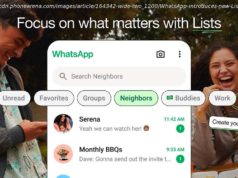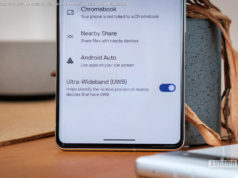HTC has unveiled the U12+, with a 6-inch screen, dual cameras, and a doubling-down on Edge Sense.
The screen on the HTC U12+ doesn’t have a notch.
Whether that’s a conscious decision or the result of a design team decimated by Google’s billion-plus purchase of the company’s smartphone division is up for debate, but the fact of the matter is, HTC’s newest handset stands out among this year’s crop of Android phones for the same reason last year’s U11 did: It doesn’t follow the latest trends.
The bezels on the HTC U12+ (right) have been dramatically trimmed from last year’s U11 (left).
But this time around, HTC’s flagship certainly feels like a 2018 phone. HTC has upgraded the screen from 5.5 inches to a 6 inches and switched from a 16:9 ratio to an 18:9 one, so there’s a whole lot more screen in a similar body. The stale home button that adorned the front of the U11 is gone as well, and the bezels have been dramatically trimmed all around, resulting in a svelte, alluring design that stacks up well next to the Galaxy S9 and LG G7 ThinQ.
Or specifically, the Galaxy S9+. HTC is officially calling its new phone the U12+ to match up with Samsung’s larger flagship phone, not to differentiate between it and a smaller model. In fact, HTC told me that there’s no companion HTC U12 in the works, so if you’re hoping for a 5.5-inch version, it’s probably not coming. Basically, it’a plus or nothing.
Nearly every component inside the U12+ has gotten an upgrade from the U11, and you’re not likely to find a phone with better specs until much later in the year:
The design of the U12+ carries over the “liquid surface” design language HTC introduce with the U Ultra (which was its only redeeming value), and it’s just as attractive to fingerprints as it was on last year’s phones. However, it’s hard to deny how striking it is, particularly when it captures a ray of light. HTC has amped up the colors as well, darkening the trademark blue and adding a touch of translucence to show off the camera sensors and other internal parts, and bringing back the Iron Man-esque solar red.
The slightly translucent back on the U12+ is simply gorgeous.
Despite the larger screen, the HTC U12+ is as easy to hold and pocket as the U11 thanks to the 18:9 ratio and slimmer bezels. The U12 has clear physical similarities to the U11, but the design has been refined all around, and it feels much closer to a modern handset than the U11 did.
Edge Sense, HTC’s big innovation on the U11 that lets you launch apps and actions by squeezing the sides of the phone, makes a return on the U12+, and it comes with a few new tricks in tow. Since we last saw it on the Pixel 2, Edge Sense has been retooled and upgraded for the U12, and in the process might have graduated from a barely used gimmick to a genuinely useful feature.
The buttons on the HTC U12+ don’t actually move.
For one, HTC has added a nifty back action to the squeeze function to help with navigation, but the best part of Edge Sense on the U12+ are the touch-sensitive sides of the phone. You can double-tap the side to engage any action or launch an app, but HTC enables one-handed mode by default, and it’s kind of brilliant. Tap twice on either edge and it’ll shrink the screen toward the finger doing the tapping. Additionally, the phone can sense how you’re holding it and automatically keep the screen on and the orientation locked so you won’t need to keep tapping the screen and flipping your wrist when trying to read a story in bed.
Even the buttons on the HTC U12+ are edge sensing. When you press them, you’ll get haptic feedback rather than physical clicking, and they definitely take some getting used to. Also, since they’re not actual buttons, they won’t work at all when the phone is dead. I’m not entirely sure of the benefit here, as I never had a problem with the buttons on any of my other phones.
You can check out the new Edge Sense features in the video above, and I found them to be downright delightful in my brief hands-on. The tap-to-shrink option is particularly interesting, as one-handed mode is a feature I usually forget to use. Auto-orientation lock was also cool, and the phone was smart enough to understand when I was holding it in portrait mode. The new Edge Sense features might not be enough to convince people to plunk down $800 on an HTC phone over a Samsung or Apple one, but they’ll definitely be a nice addition to the Pixel 3, assuming Google steals it.
HTC has completely revamped the camera on the HTC U12+, adding a second lens to both the front and back cameras. On the back there’s a 12MP wide-angle f/1.75 main lens paired with a 16MP telephoto one that delivers portrait mode and 2X optical zoom. The front has dual 8MP so you can take realistic portrait selfies without relying on digital tricks.
The HTC U12+ has a dual camera on the back and the front.
I didn’t get a chance to test the camera too strenuously, but one feature I liked is the ability to change the focal point after snapping a portrait shot. It’s similar to adjusting the intensity of the background blur on Samsung’s Live Focus, but instead of a slider, you can tap various points on the screen to adjust the bokeh focus. It was particularly useful with the front camera when you have several faces in a shot.
Elsewhere, the HTC U12+ doesn’t have a 3.5mm headphone jack, so you’ll need to use the bundled Sonic earbuds to get the best sound quality. It also features always-on support for Amazon Alexa and Google Assistant, and it’s dialed back its own Sense Companion.
Two of the HTC U12+’s colors are available now, but you’ll have to wait for the solar red.
You can preorder the 64GB HTC U12+ in black or translucent black on HTC.com for $799. There is also a 128GB model in translucent blue for $849, with solar red arriving laster this year.






